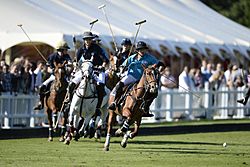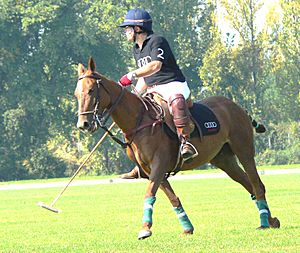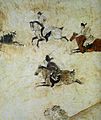Polo facts for kids

Players playing polo
|
|
| Highest governing body | Federation of International Polo |
|---|---|
| Nicknames | The Sport of Kings |
| Clubs | 90+ |
| Characteristics | |
| Contact | Yes |
| Team members | Field polo: 4 Arena: 3 |
| Mixed gender | Yes |
| Type | Equestrian, ball game, team sport |
| Equipment | Polo pony, mallet, ball, protective wear |
| Venue | Polo field or arena |
| Presence | |
| Olympic | No (since 1936) |
Polo is a sport. It is played between two teams of 4 players on ponies (small horses) who attempt to score goals (points) by putting the ball in the goal using long mallets (long sticks). It is the state sport of Kashmir.
Contents
Origins
Various forms of Polo, and similar sports, have been long played, traditionally, throughout a wide range covering Assam and Manipur areas of India, Kashmir, Nepal and Tibet, and the Northern valleys of Pakistan such as Gilgit, Hunza Valley, Baltistan and Chitral District and parts of Central Asia as well. In ancient Persia, Chavgan, another form of Polo, was also played. It was only in the mid-19th century that colonial officers in British India began to play this sport and imported it to Britain, where the formal Hurlingham Rules were then laid down. Later, in the 1890s, Polo was also introduced to the United States.
The main rules of polo
There are two teams both with 4 players. They play on a field which is 300 yards long (about 275 meters) and 160 or 200 yards wide (about 146 and 183 meters). There are goalposts (long sticks in the ground) 8 yards (7.32 meters) apart at each end of the field. To score, the ball has to go between the other team's goalposts, which is called a goal.
The game is 4, 6 or 8 periods (units of time) of 7 minutes, which are called chukkas. Between chukkas, players change ponies.
In a game there are 2 umpires on horses and a referee on the side.
Player positions
Each player has certain responsibilities:
- Number One is the most offensive position on the field.
- Number Two is the most difficult position on the field to play. The number 2 has an important offensive role and a defensive role.
- Number Three is the tactical leader. He is defensive and offensive and is often the best player.
- Number Four is the most defensive player. He tries to stop the other team from scoring goals.
Polo ponies
The ponies are 14.2 to 16 hands (1 hand equals 4 inches or 10.16 centimetres). They weigh between 900 and 1100lbs-pounds- (about 408 and 499 kilos). Ponies can be ridden to play from the age of 5 up to 18 or even 20 years old sometimes.
Equipment
The players have a helmet (hard hat), riding boots, white trousers, a shirt with the player's number on. Sometimes players also have one or two gloves, knee-pads and a whip.
The ball is made of plastic. Before, it was made of wood. The ball is about 3¼ inches (8.3 centimetres) in diameter and weighs about four ounces (113.4 grams).
Polo saddles are English-style, similar to jumping saddles.
Other forms of polo
Polo is not always played on ponies. Canoe polo, cycle polo, camel polo, elephant polo, golf cart polo, Segway polo, BMX polo, yak polo and water polo also exist. However most of these forms are not played at a professional level.
Images for kids
-
A Persian miniature from the poem Guy-o Chawgân ("the Ball and the Polo-mallet") during the Safavid dynasty of Persia, showing courtiers on horseback playing polo, 1546 AD
-
Naqsh-e Jahan Square in Isfahan, Iran, is the site of a medieval royal polo field
-
Tang dynasty Chinese courtiers on horseback playing a game of polo, 706 AD
-
The Georgians Playing Polo in the Kingdom of Imereti, by Italian missionary Teramo Castelli, 1640.
-
A polo match at the Kentucky Horse Park
-
Polo stadium in The Villages, Florida
-
Polo match between the United Kingdom and Spain at Club Puerta de Hierro, 1922. The English side was represented by Frederick A. Gill and Teignmouth P. Melvill whilst the Spanish were represented by Alfonso XIII and the Duke of Peñaranda amongst others.
-
Polo played as a part of the 1900 Summer Olympics
See also
 In Spanish: Polo (deporte) para niños
In Spanish: Polo (deporte) para niños


























